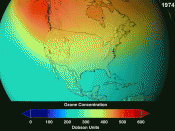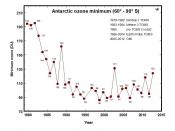Americans invest a great deal of effort in monitoring and cultivating their physical, financial, and human capital. The environment and the ecosystem, on the other hand, are just beginning to receive attention. Over the last three decades, there has been a growing recognition that pollution poses a serious threat to human population and global ecosystems. One realization is that the ozone layer is weakening. In fact, estimates show that the ozone hole is as big as North America, 9 million square miles. The ozone is a shield that absorbs and protects the earth from ultra-violet rays. Ozone depletion allows an increase of damaging ultra-violet rays that enter the atmosphere. Scientists believe that extra UV-Rays can cause cancer, cataracts and damage to agriculture Ozone, however, does have some practical uses such as: purifying water, sterilizing air and bleaching certain types of food. I will discuss what the ozone is, the cause for the erosion, and possible solutions.
The ozone is a transparent blanket in the atmosphere that aids and protects the earth. An astronaut looking back at earth can see this thin shell containing our atmosphere. This thin shell is the ozone shield. Ozone was discovered not because people were concerned with solar radiation's effects, but because of inquisitiveness to the world around them. Intrigued with nature, scientists sought to determine the atmosphere's composition. In the1800's, scientists were only able to identify nitrogen and oxygen because these elements exist in large quantities. Virtually all other gases where undetectable because they're quantities were so minute. The technology did not exist to discover molecules one-millionth in frequency. Today we have identified over 3,000 compounds in the atmosphere.
The creation of spectrums allowed chemical measurements to be taken by using wavelengths. These wavelengths were able to detect gases by signifying gas traces, a type...


